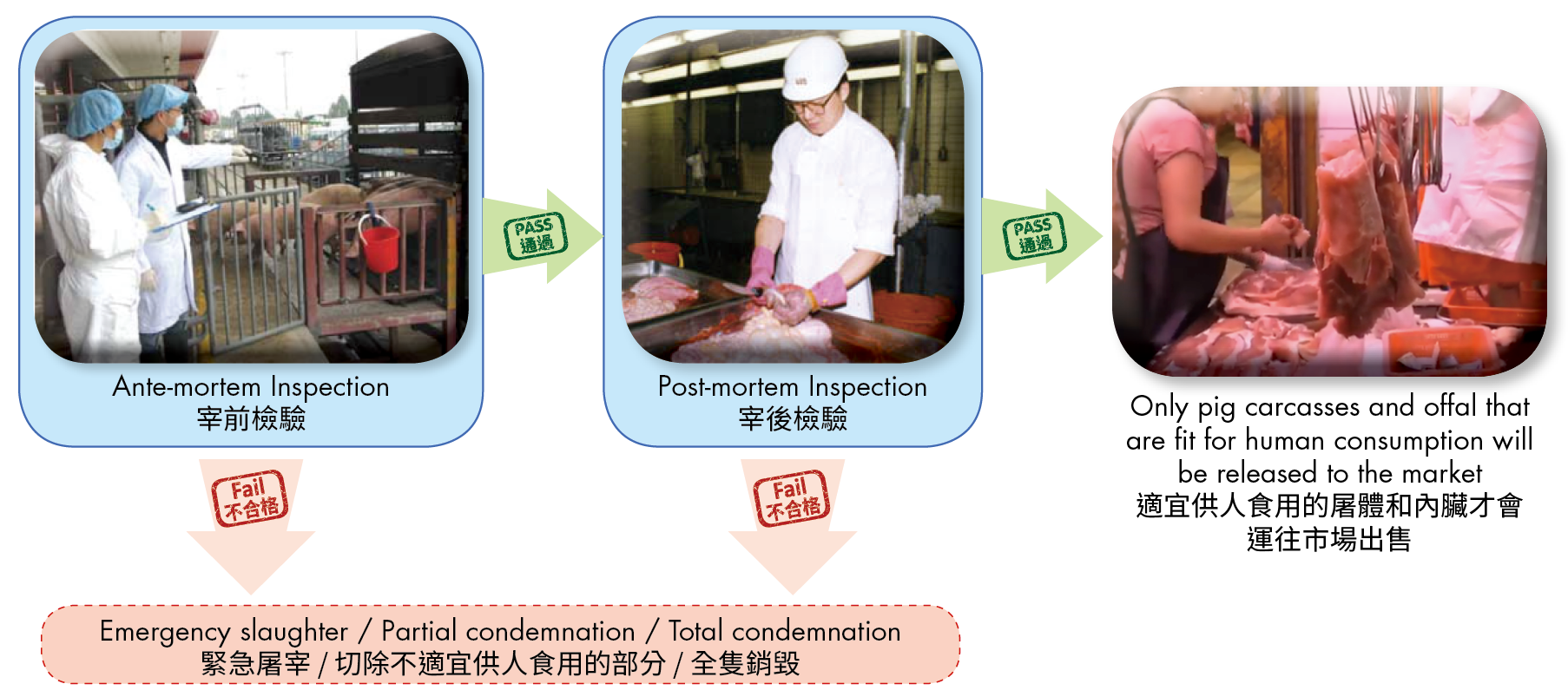
Food Safety Focus (158th Issue, September 2019) – Incident in Focus
Updates on Action against African Swine Fever
Reported by Dr. Samantha Lee, Veterinary Officer,
Slaughterhouse (Veterinary) Section , Centre for Food Safety
Following two cases of African Swine Fever (ASF) detected in imported pigs in May, ASF virus was detected in samples collected from three dead pigs at Sheung Shui Slaughterhouse (SSSH) on 3 September 2019. In light of Hong Kong’s unique situation and learning from the first two incidents, the Centre for Food Safety has adopted new control measures. These measures are elaborated below:

All local and imported pigs have to undergo ante-mortem and post-mortem inspections in slaughterhouses to ensure they are fit for human consumption before being released to the market.
Hong Kong Pork Supply
Unlike some overseas countries, the Hong Kong pork market comprises not only frozen and chilled pork but also freshly slaughtered “warm” meat derived from live pigs. Traditionally, the warm meat market relies heavily on import.
ASF Challenges Faced by Hong Kong
“China is going to deal with this African Swine Fever for many years to come.”, remarked by Dr. Matthew Stone, Deputy Director-General of the World Organisation for Animal Health (OIE) at the 87th OIE General Assembly, With Hong Kong’s heavy reliance on import for live pigs and pig products, even though a package of preventive measures have been put in place to guard against ASF from the sources and along the supply chain, the risk of further occurrence of ASF cases remains.
Action against ASF Case Detected in September
While ASF does not infect humans or pose food safety risk, it could have devastating impact on the local pig rearing trade if it establishes its foothold in Hong Kong. After the first two ASF cases in May, the Government, having taken into account the views of local and overseas experts and with the support of live pig trade, has imposed a daily clearance arrangement whereby all live pigs are slaughtered within 24 hours upon admittance into the slaughterhouse. Lairages in different areas of the slaughterhouse are cleared out for thorough cleansing and disinfection on a daily basis. Since the period for pigs staying in the slaughterhouse is short, together with enhanced cleansing and disinfection of pig carrying vehicles, the new arrangement can significantly reduce the risk of ASF spreading in Hong Kong. In addition, the Agriculture, Fisheries and Conservation Department has implemented various preventive measures against ASF, among others, including requesting pig farmers to adopt proper biosecurity measures, strictly controlling the vehicles and personnel entering pig farms, strengthening periphery of pig farms to prevent wild pigs from entering, recommending pig farmers to ban staff from bringing pork and pork products into the farms, enhancing the cleansing and disinfection of vehicles and personnel entering and leaving pig farms as well as carefully handling excrement, etc.
At the second meeting of the Standing Group of Experts on ASF organised by the OIE and the Food and Agriculture Organization of the United Nations in July 2019, experts had an in-depth discussion on the prevention and control measures against ASF. They opined that each region should take its own situation, such as the stocking density, demand and supply of live pigs, etc. into consideration in formulating effective and practical local control measures. Given that both SSSH and Tsuen Wan Slaughterhouse have already implemented the daily clearance arrangement, the experts, in addition to other experts the government consulted earlier, considered that the possibilities of infection and spread of the virus to other pigs in Hong Kong have been largely minimised. Therefore, if ASF virus is detected in pigs in a local slaughterhouse, closure of the slaughterhouse and culling of all pigs present might not be necessary. After all, only pigs that are fit for human consumption will be released to the market after stringent ante-mortem and post-mortem inspections in slaughterhouses. Pork should be well cooked before consumption.
Key Points to Note:
- ASF does not infect humans and has no food safety concern.
- Enhanced preventive measures against ASF have been implemented to largely minimise the possibilities of infection and spread of ASF virus to other pigs in Hong Kong.
- If ASF is detected in a local slaughterhouse, closure of the slaughterhouse and culling of all pigs present might not be necessary. Only pork that is fit for human consumption will be released to the market.

